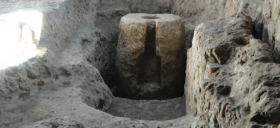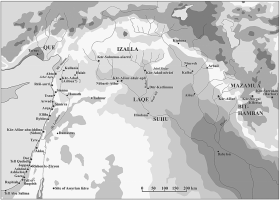The Practice of Repairing Vessels in Ancient Egypt: Methods of Repair and Anthropological Implications
Before mass production, the practice of repairing ceramic and stone vessels, as well […]
A Rare Discovery at Tel Achziv: A Phoenician Clay Mask Mold from the Ninth Century B.C.E.
Renewed excavations on the tell of Achziv in the north of Israel by a French-Israeli team have led to the discovery […]
Masculinities and Third Gender: Gendered Otherness in the Ancient Near East
Their masculine identity was considered to be ambiguous. These persons can be classified as belonging to a third gender. […]
A Clay Bread Stamp from Khirbet et-Tireh
The clay bread stamp presented here was found at in a monastic complex dating to the Late Byzantine-Early Islamic period at Khirbet et-Tireh, approximately 16 km northwest of Jerusalem. […]
Diodorus of Sicily’s Library and the Ancient Near East
Though I was acquainted with the figure and work of Diodorus of Sicily, it only became familiar to me thanks to my work on another Greek author, Ctesias of Cnidus. Fifteen-odd years ago, I started to […]
The Empire and the “Upper Sea”: Assyrian Control Strategies along the Southern Levantine Coast
Being the world’s first political rule to adopt an imperial structure – Assyria was a land-locked power with no real maritime experience. Ideologically, the Assyrians […]
World Heritage Day Symposium Twitter Recap
World Heritage Day—Protecting, Preserving, and Presenting the Cultural Heritage of the Near East to the Public ASOR and AIA (The Archaeological Institute of America), in cooperation with the Smithsonian Institution […]
Violence and the City: On the Yahwist’s Leviathan [PODCAST]
Continuing our look inside the recent special Near Eastern Archaeology issue on crime and punishment in the Bible and the Near East, we spoke with Dr. Robert Kawashima about his article, “Violence and the […]
Archaeology Weekly Roundup! 10-25-13
If you missed anything from the ASOR facebook or twitter pages this week, don’t worry. We’ve rounded up some of this week’s archaeology news into one convenient post. If we missed any major archaeological stories from this week, feel free to let us know in the comment section! The Home of the Last Neanderthals 250,000 […]
Joint Custody: An Archaeological Park at Neolithic Ghwair I, Jordan
ANE Today Editorial Introduction:* Ecotourism is quickly becoming a means for the public to appreciate archaeological sites, even in remote regions. We are pleased to present this article by Alan Simmons and Mohammad Najjar abridged from the latest edition of Near Eastern Archaeology on a case study from Jordan. By: Alan H. Simmons and Mohammad […]
Hazor in the Ninth and Eighth Centuries BCE: From Omri to the Assyrian Destruction.
ANE Today Editorial Introduction:* David and Solomon are controversial historical figures, but their successors, especially the Israelite dynasty of Omri, are not. Hazor was a thriving center of the northern kingdom of Israel. Its extensive remains illustrate the life of Iron Age cities as they fell under the shadow of the Assyrian onslaught. By: Débora […]
The So-Called “Solomonic” City-gate at Megiddo
Editor’s Note: The “Solomonic” gates at Hazor, Gezer and Megiddo have long been controversial for their apparent confirmation of Biblical accounts. Below, Prof. David Ussishkin, the excavator of Lachish and Megiddo, argues that the six-chambered gate structure at Megiddo cannot be dated to the tenth century and the reign of Solomon. What is the proper […]
The Renewed Hazor Excavations
By: Amnon Ben-Tor, The Hebrew University of Jerusalem Edited and abridged from NEA 76.2: 66–67 (see editorial note below) Tel Hazor, “the head of all those kingdoms” (Joshua 11:10), is the largest tell in Israel and encompasses a total of approximately 800 dunams (200 acres). With the exception of two gaps in the settlement, […]
2012 ASOR Annual Meeting Is a Tremendous Success
TheASOR Annual Meeting in Chicago breaks records and is a tremendous success! A record 925 ASOR members gathered in Chicago from November 14–17 for theASOR Annual Meeting. The annual conference is the premier gathering for scholars, students, and lay enthusiasts who conduct research or are interested in the history and archaeology […]
Get access to the latest issue of Near Eastern Archaeology for free!
To access this issue go to our facebook page and like it if you haven’t already, then click the link near the top of the page to go to JSTOR. If you can’t find the link, look for the picture of Petra, the link is above it! The next page will ask you to […]
NEA 75.2 (June) Letter from the Editor -Issue Available Online on JSTOR
The latest issue of Near Eastern Archaeology is available now on JSTOR! Check it out here. From the Editor It gives me great pleasure, as the new Editor of Near Eastern Archaeology, to present the June issue of the journal. Publishing Near Eastern Archaeology continues to be both a challenge and an opportunity. The challenge […]
Free JSTOR Access and New NEA!
There’s a week left to access the full runs of all of ASOR’s three journals though JSTOR, so if you haven’t signed up, do it now! Click the button in our sidebar or click here to go to JSTOR and get free access to all our journals. And now the latest issue of NEA is […]
ASOR Search for NEA editor
Near Eastern Archaeology (NEA), a publication of the American Schools for Oriental Research (ASOR), is seeking an editor for a three-year term beginning January 1, for twelve quarterly issues. NEA is a peer-reviewed, illustrated publication intended for non-specialists. The journal accepts submissions pertaining to the prehistory and history of the Near East. The duties […]
NEA 74.2 (June) is available online for subscribers
ASOR is pleased to announce that NEA 74.2 (June) has now been posted online at Atypon Link. This issue (and 4 years of back issues) is available to online subscribers of NEA and to ASOR members who have chosen an online subscription as part of their membership. The following is an abbreviated table of […]









